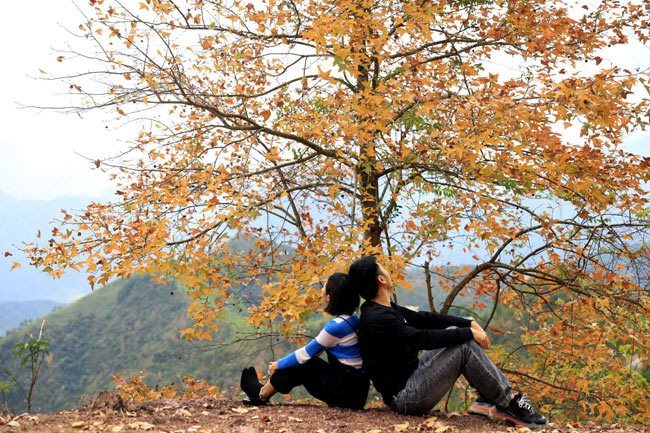 |
| A couple enjoy the foliage of maple tree |
The fantastic view of maple trees with all their leaves changing from green to red is common in countries such as Japan, South Korea, China and Canada. However, it is rare in Vietnam. When fall comes, Vietnamese go on tours of these destinations to watch red maple trees.
However, in the past few years, young travelers have detected maple tree forests in northern Vietnam. Maple leaves in the north go red in mid- and late winter as Vietnam’s weather is not as cold as in temperate countries.
Although maple forests in Vietnam are small in size and incomparable with counterparts in the above countries, the forests still have their own romantic beauty enough to immerse visitors.
The author suggests some attractions which may be attractive to tourists.
As cable cars to Fansipan Peak are available now, tourists—especially those who love mountain climbing—have recently shifted from trekking Fansipan mountain range stretching along Lao Cai and Lai Chau provinces to trekking Ta Lien and Putaleng mountains in Tam Duong District, Lai Chau Province.
According to Giang A Pao, a Mong ethnic porter, who is in charge of guiding climbers to the two mountains, at the height of 2,000 to 2,500 meters are charming maple forests with age-old trees whose trunk is so big that one is unable to embrace the whole of it.
In the mid-winter, or mid-January, the natural painting of wild forests highlights maple trees. Their trunk is covered by green moss while their leaves are in red.
It is not difficult to get there. From Hanoi, tourists catch a coach at My Dinh Coach Station or drive a motorbike to Lai Chau’s Tam Duong District where they can start their journey to Ta Lien and Putaleng mountains. Hiring a Mong ethnic porter to support you during the exploring trip is essential.
Mountain with “dinosaur’s backbone”
Ta Xua Mountain in Tram Tau District, Yen Bai Province, well-known by its “dinosaur’s backbone,” is a favorite trekking spot. Visitors to the mountain are enchanted by do quyen (Rhododendron) flowers which bloom in summer and red maple trees in winter.
A traveler who has experienced Ta Xua trekking route said he and his friends made a trip to the “dinosaur’s backbone” during New Year holiday. On a location some 2,000 meters above sea level, they felt excited when seeing a yellow and red maple forests standing out against the sky. It was such an unforgettable scenery.
From late November on is the best time to enjoy the red maple season on Ta Xua Mountain. The 2,865-meter mountain can be accessed from many paths. Visitors who want to admire the maple forests should tell their porters in advance. The trip always starts in Ban Cong Commune, which is 230 kilometers from Hanoi.
Binh Lieu bordering path
Binh Lieu is a mountainous district in Quang Ninh Province, which borders China. The location boasts majestic terraced rice fields and pristine mountains.
Those visiting Binh Lieu in winter should enjoy Binh Lieu bordering path, around 260 kilometers from Hanoi, where communities of maple trees exist side by side. In winter, those maple trees in yellow or red offer perfect settings for photo sessions.
It takes tourists only two days to make the trip to Binh Lieu bordering path to see red maple forests. Unfortunately, as it is in the border area, the trip is for Vietnamese only.
The maple forest in Chi Linh
Tam Ban Mountain in Chi Linh District, Hai Duong Province, is home to a maple forest covering 100 hectares, stretching from the mountainside to the peak, 150 to 200 meters above sea level. Half hidden in the forest is the ancient Thanh Mai Pagoda.
When the red maple leaf season comes, from January to February, the old religious complex emerges into the foliage of maple trees. The colder the weather is, the redder the maple leaves become.
The unique maple forest is just 85 kilometers from Hanoi.
Aside from the four above-mentioned attractions, maple trees can also be found on mountains overlooking the Quay Son River in Cao Bang Province, forests on Hoang Lien Son Mountain, Hue and Dalat. SGT
Hai Duong
 Some locations in northern Vietnam boast forests of maple trees whose leaves turn red in autumn.
Some locations in northern Vietnam boast forests of maple trees whose leaves turn red in autumn.